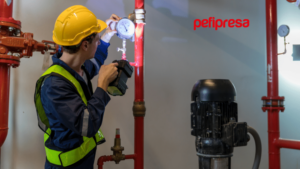The installation of Fire Protection Systems (FPS) in Data Processing Centers (DPCs) or Data Centers or Rack Rooms has become an indispensable practice today. Since companies depend heavily on their computer systems, ensuring the security of data and equipment is an absolute priority.
This article analyzes how FP systems play a crucial role in preventing and mitigating fires in these environments.
The importance of data processing centres and their vulnerability to fire
The Data processing centres or computer rooms, house servers and computer equipment of great economic and operational value, as well as storing large volumes of data in small spaces. This concentration of equipment can generate high thermal loads and, therefore, increase the risk of fire.
Likewise, business continuity and information protection become essential, since any interruption in the operation of the data processing centre can have serious consequences.
The solution: install FP systems in data centers
To meet these challenges, a growing number of companies are choosing to install advanced fire protection systems in their data centers. These systems are designed to quickly detect and extinguish any outbreak of fire, minimizing damage and avoiding interruptions in the operation of the data center.
A prominent example is the automatic extinguishing system for racks, offered by PEFIPRESA in collaboration with MINIMAX. This system provides optimal protection by automatically detecting and extinguishing fire in monitored racks, preventing it from spreading and causing further damage.

How Rack Protection Systems Work
These systems operate automatically and use various detection methods, such as aspiration smoke detectors or temperature sensors, to identify any change in environmental conditions. Once a potential fire is detected, the extinguishing system is automatically activated, which can use gaseous extinguishing agents or water mist systems.
The main advantage is their rapid and efficient response capacity, which reduces response time and, consequently, damage caused by fire. In addition, as they are designed to take up minimal space, they do not compromise the compact configuration or functionality of the data center.
Benefits of implementing Fire Protection systems in data centers
Implementing FSS (Fire Safety Systems) in data centers offers multiple benefits:
Greater security and business continuity:
Having an efficient fire protection system provides peace of mind and reduces the inherent risk of possible catastrophes.
Regulatory compliance:
These systems facilitate compliance with security requirements and regulations established by industry standards and regulations, ensuring the protection of data and computer equipment.
Cost reduction and risk mitigation:
The rapid response of FP systems minimizes damage and prevents prolonged interruptions, which can translate into significant savings compared to the high costs associated with unexpected downtime.

Consequences of a Fire in a Data Center
A fire in a data center can have devastating consequences. In addition to the financial costs of replacing damaged equipment and recovering data, downtime can disrupt business operations, leading to dissatisfied customers and significant revenue losses.
In some large companies, the cost of an interruption has been found to exceed €2 million per hour.
In the worst case, a fire could even lead to a complete cessation of activity, making investment in FP systems an unavoidable necessity that can be met by a company specializing in fire protection in racks.

The implementation of Fire Protection systems in Data Processing Centers is becoming more common and necessary to ensure information security and business continuity.
FP systems, such as the automatic extinguishing system for racks offered by PEFIPRESA and MINIMAX, play a fundamental role in the prevention and mitigation of fires in these environments. Their rapid response capacity, together with compliance with safety regulations, make their implementation a mandatory investment in a world increasingly dependent on technology.









